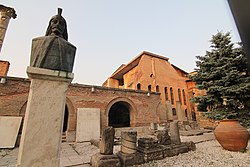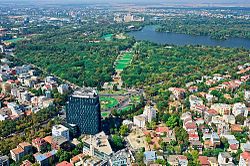Bucharest
Bucharest is the capital city of Romania. It is the largest city in the country. The city has a population of 1.9 million people.[1] It is made up of 6 "sectors". It has a humid continental climate (Cfa in the Koeppen climate classification). It became the capital of Romania in 1862. It is the centre of Romanian media, culture and art. Bucharest is the 6th largest city in the European Union by population within city limits.
|
București | |
|---|---|
Capital City | |
 | |
|
| |
|
| |
| Coordinates: 44°25′57″N 26°6′14″E / 44.43250°N 26.10389°ECoordinates: 44°25′57″N 26°6′14″E / 44.43250°N 26.10389°E | |
| Country | Romania |
| County | None1 |
| First attested | 1459 |
| Government | |
| • Mayor | Sorin Oprescu (Independent) |
| • Prefect | Georgeta Gavrila |
| Area | |
| • Capital City | 228 km2 (88 sq mi) |
| • Urban | 285 km2 (110 sq mi) |
| Elevation | 55.8–91.5 m (183.1–300.2 ft) |
| Population (2011 census) | |
| • Capital City | 1,883,425 |
| • Rank | 1st in Romania |
| • Density | 8,260/km2 (21,400/sq mi) |
| • Urban | 1,931,000 |
| • Metro | 2,272,1632 |
| Time zone | UTC+2 (EET) |
| • Summer (DST) | UTC+3 (EEST) |
| Postal Code | 0xxxxx |
| Car plate | B |
| Website | Official site |
| 1Romanian law stipulates that Bucharest has a special administrative status which is equal to that of a County; 2Bucharest metropolitan area is a proposed project. | |
| Wikimedia Commons has media related to Lua error in Module:Commons_link at line 62: attempt to index field 'wikibase' (a nil value).. |
According to European standards, Bucharest is an old city. The first mention of it appears in 1459. Its eclectic architecture is a mixture of historical, transitional, Communist and modern styles. In the period between the two World Wars, thanks to the elegant urban architecture and ingenuity of the urban elite, Bucharest was named "Paris of the East", or "Little Paris" (Micul Paris).
Bucharest Media
Often compared to the Champs-Élysées, the current Calea Victoriei becomes a pedestrian zone on the weekend.
The Old Princely Court (Curtea Veche), the former residence of ruler Vlad the Impaler, is located in the Old Town.
Bucharest is Romania's capital and largest city.
References
- ↑ "Structura Etno-demografică a României". www.edrc.ro.











